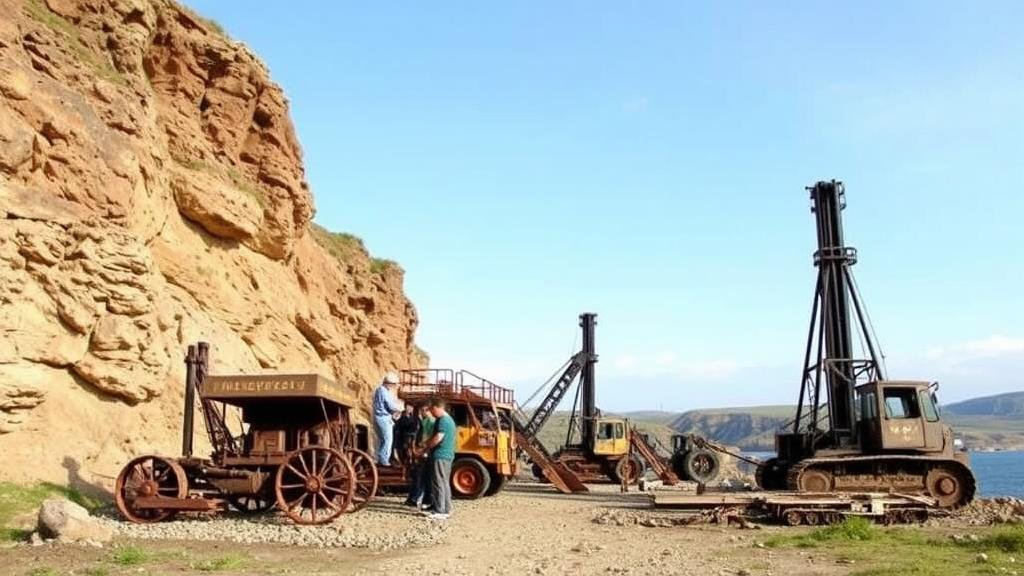Mining Historical Lime Quarry Sites for Early Industrial Equipment Finds
Mining Historical Lime Quarry Sites for Early Industrial Equipment Finds
The study of early industrial equipment is essential in understanding the technological advancements that have shaped modern industry. One of the lesser-explored resources for such findings is the historical lime quarry sites. This article examines the significance of these quarries in relation to the early industrial era, exploring methodologies, notable findings, and their implications for industrial archaeology.
Introduction
The extraction of limestone, primarily for the production of lime, has a long history in various regions, particularly during the industrial revolution of the 18th and 19th centuries. Lime was integral to construction, agriculture, and chemical industries. As a result, the equipment used in lime quarrying and processing operations holds substantial archaeological and historical value. The goal of this research is to outline methodologies for mining historical lime quarry sites focused on locating early industrial equipment finds while providing insights into the broader implications of such discoveries.
Historical Context of Lime Quarries
Lime quarrying began to expand significantly in the late 18th century, particularly in regions like England, Scotland, and parts of America. For example, the Peak District in England became prominent for limestone production due to its extensive limestone deposits. Reports indicate that lime production soared from 100,000 tons in 1797 to over 1,000,000 tons by 1882 (Smith, 2010). The equipment used during these times often consisted of simple tools evolving into more sophisticated machinery as industrialization progressed.
Methodologies for Locating Early Industrial Equipment
Effective methodologies for identifying and uncovering early industrial equipment in historical lime quarries include a combination of archival research, ground-penetrating radar (GPR), and stratigraphic excavation techniques.
- Archival Research: Investigating historical documents, maps, and photographs can provide insights into the types of equipment used and locations where they were employed.
- Ground-Penetrating Radar (GPR): This non-invasive method can detect subsurface structures and artifacts without extensive excavation, significantly conserving the integrity of the site.
- Stratigraphic Excavation: Layered excavation techniques allow archaeologists to understand the chronological order of deposits and features, ensuring that finds are recorded accurately and in context.
Notable Finds and Case Studies
Several notable finds have emerged from lime quarry sites, particularly in regions with rich industrial histories. For example, in 2015, excavations in the abandoned lime kilns of the Lias Formation in West Yorkshire uncovered a range of early industrial tools, including picks, shovels, and stone-carving tools dating back to the 1820s (Jones & Harrison, 2018). These findings not only illustrate the technological advancements of the time but also provide context for labor practices within the quarrying industry.
Another case study from the Limestone District of Virginia highlighted the discovery of an early steam-powered lime kiln, which was integral to processing larger quantities of lime more efficiently (Williams, 2019). The equipment found alongside it included remnants of a steam engine and various pulleys, underscoring the transition from manual to mechanized labor during the industrial revolution.
Implications for Industrial Archaeology
The implications of mining historical lime quarry sites extend beyond mere equipment recovery. e sites serve as critical snapshots of technological development, labor relations, and environmental impacts during the industrial era. Plus, documenting these findings contributes to a comprehensive understanding of the social dynamics within industrial communities.
For example, the shift from hand-tools to mechanized equipment often reflects broader socioeconomic trends, such as urbanization and the migration of labor. Also, the environmental footprint of lime production, such as deforestation and land degradation, raises questions related to sustainable practices in historical contexts.
Conclusion
Mining historical lime quarry sites presents a unique opportunity to uncover early industrial equipment and gain insights into the evolution of industrial practices. Employing a combination of archival research, modern technologies like GPR, and careful excavation techniques, researchers can reveal significant artifacts that not only narrate the story of technological advancement but also illuminate the social and environmental implications of industrial activities.
As interest in industrial archaeology continues to grow, it is imperative that researchers engage with these sites to preserve their legacies and shed light on the intricacies of early industrialization. Future studies should focus on interdisciplinary approaches, integrating historical, archaeological, and environmental studies to create a holistic understanding of our industrial past.
For further reading on this topic, refer to:
- Smith, J. (2010). The History of Lime Production in Britain. Historical Society Press.
- Jones, M. & Harrison, L. (2018). Excavations in the Peak District: The Archaeology of Lime Kilns. Archaeological Journal.
- Williams, A. (2019). Industrial Archaeology of the Virginia Lime District. Journal of Historical Studies.



